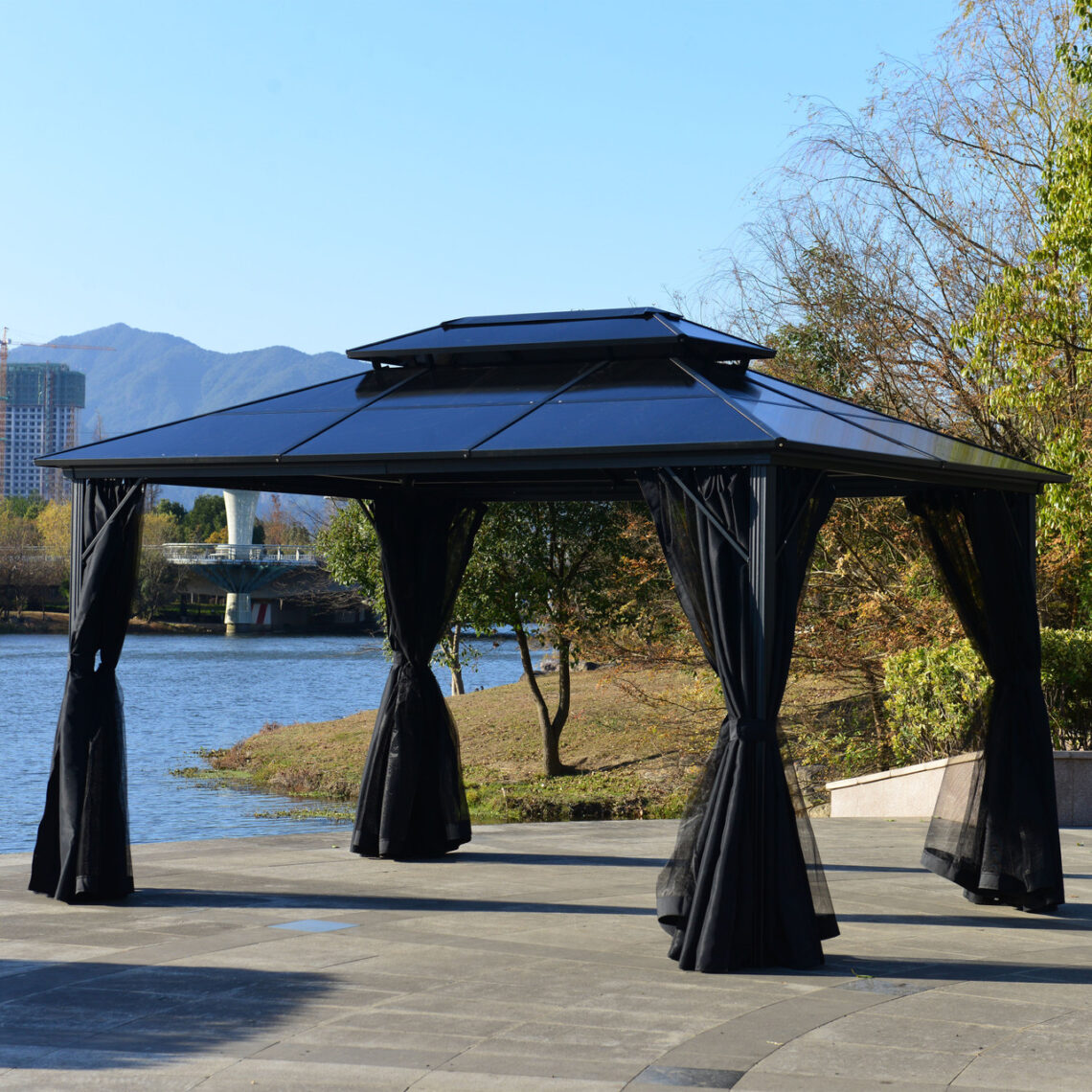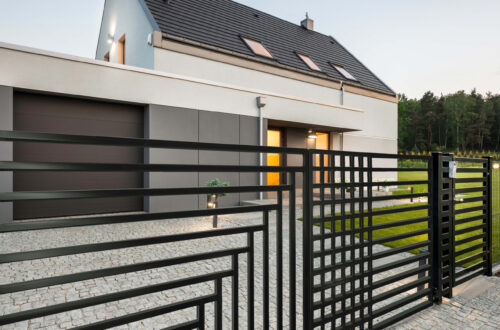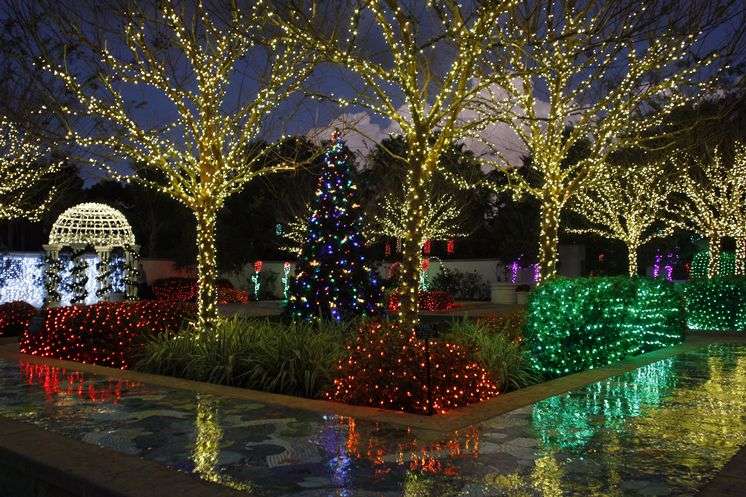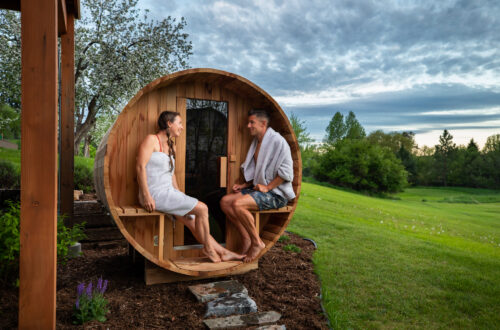If you’re looking for a way to spend more time in your garden while still enjoying shelter from the sun and comfortable seating, a gazebo could be just the solution you need. But just what is a gazebo?
Put simply, a gazebo is an outdoor structure with a solid roof and open sides. It’s designed to provide fresh air, privacy, and garden views.
A gazebo can serve many purposes: a shaded seating area, an outdoor dining room, an outdoor kitchen, a place for a hot tub or spa, or a garden focal point. Adding one of these charming structures to your landscape isn’t as complicated as you might think. In this guide, we’ll cover everything you need to know about gazebos, including materials, installation, and maintenance.
What Makes a Gazebo?
Gazebos, pergolas, pavilions, summerhouses: You might know gazebos by these or many other names. No matter what you call it, whether you’re distinguishing between a pergola vs gazebo structure, a gazebo has a few common features:
- A freestanding structure with a closed roof and open sides
- May or may not include a central platform
- May be square, circular, or hexagonal
- Can be made from a variety of materials, including wood, metal, and plastic
In the past, gazebos were most commonly built from wood. Wood gazebos are durable but require more maintenance and upkeep than those made from other materials. Nowadays, metal, plastic, and vinyl gazebos are more popular choices because they are low maintenance, easy to assemble, and can even be moved if needed as they are not a permanent structure.
5 Gazebo Uses
Gazebos have been a favorite garden feature for centuries, serving as temples, shrines, grape arbors, and tea houses. What is a gazebo used for today? The possibilities are nearly endless, but here are five of our favorite ways to use a backyard gazebo.
#1 Outdoor Entertaining
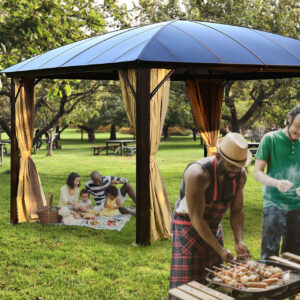
A gazebo can be the star of outdoor events and parties like barbecues, birthdays, and weddings. Think of your gazebo as the hub for your gathering, and try these tips to make the most of it:
- DIY dance floor – If your gazebo does not have a platform, place it on a hard, level surface like a deck or patio. Hang portable bluetooth speakers at the corners, and voila—instant dance floor.
- Snack station – To protect your spread from sun and insects, make your gazebo the designated food area. Set up tables buffet-style, and add screen curtains to the sides of your gazebo to keep out bugs and provide shelter from wind.
- Photo backdrop – With a few extra decorative touches, your gazebo can make a charming background for photos. Floral garlands, paper lanterns, or hanging planter baskets can easily transform even the simplest gazebo into a pretty focal point.
#2 Outdoor Dining
A gazebo makes a perfect outdoor dining room, allowing you to enjoy a meal with your family and friends while being protected from the sun, wind, flying insects, and rain. Make sure your gazebo is equipped with the following:
- Curtains that zip or velcro closed to keep out bugs and hold in heat on chilly spring evenings
- Solar lights, battery lanterns, or access to an outdoor outlet to plug in string lights for evening dining
- A patio heater with proper ventilation and several feet of clearance from the roof and curtains
You’ll be able to extend your outdoor dining season by weeks to months with a fully-equipped gazebo and some stylish outdoor furniture.
#3 Hot Tub or Spa Area
If you have a hot tub or spa, a gazebo is the ideal finishing touch to add more privacy and create a cozy atmosphere.
Gazebos are available in a variety of sizes, so you should be able to find one to fit your hot tub deck. To determine the size you need:
- Measure the width and height of your hot tub or spa, including the surround
- Add enough clearance around the sides and overhead for comfort while getting in and out of your tub
#4 Garden Focal Point
A gazebo is a beautiful addition to any garden, serving as a focal point or an accent to your landscaping. Traditionally, garden gazebos were placed on a higher elevation than the rest of the property to provide the best views. Or you may wish to choose a location that receives morning sun or afternoon shade, depending on how you plan to use your gazebo.
#5 Yoga or Meditation
Some people use their gazebos as a peaceful retreat for yoga or meditation. With its natural surroundings, a gazebo can provide a calming atmosphere that’s conducive to relaxation.
- Use an outdoor carpet and throw pillows to make your gazebo comfortable for sitting
- Add curtains for private meditation time
What Is Gazebo Maintenance?
In general, not much is required to keep your gazebo in good condition. However, a little basic upkeep can prolong the life of your gazebo. For example:
- Weekly – Remove debris, webs, wasp nests, etc.
- Spring and fall – Inspect for damage, such as mold, mildew, or insects.
- Annually – Apply paint or sealant as needed, depending on the material.
For wooden gazebos, it’s especially important to check for signs of rot or insect infestation and take appropriate action. Sweeping the roof and floor regularly is a good preventative measure to keep insects out and stop moisture from building up under leaves and dirt.
For metal and plastic gazebos, dust and dirt can simply be hosed off occasionally. Use a scrub brush and soap if needed.
With smaller pop-up gazebos, it’s a good idea to disassemble and store in the winter months for weather protection purposes. UV damage, rain, and wind can damage the metal, plastic, and fabric parts of the gazebo and shorten its usable lifespan.
What Are Gazebos Made Of?
Gazebos can be constructed from a variety of materials, most often wood, metal, and plastic. Each comes with its own advantages and disadvantages.
Wooden Gazebos
- Features – Wooden gazebos are typically made from cedar, redwood, or pressure-treated lumber. They are traditional, eye-catching, and durable, lasting for many years with proper care and maintenance. They’re perfect for blending in with natural surroundings and can be stained or painted to match your home’s exterior.
- Maintenance – One disadvantage of wooden gazebos is that they are more susceptible to damage from moisture, insects, and rot and require more upkeep than other types of gazebos. The roof and floor of wooden gazebos should be swept regularly to keep them free of leaves and debris that can harbor moisture and insects. Check at the beginning and end of the season for signs of rot or insect infestation and treat as necessary. Stain or seal your wooden gazebo every few years to protect the wood from moisture damage.
- Cost – Wooden gazebos are the most expensive option. The cost for gazebo structures may range from anywhere between $2,000 to $10,000 and up depending on the size, materials, and local labor costs.
Metal Gazebos
- Features – Metal gazebos are preferred by many homeowners, as they offer several advantages over wood and plastic. Steel gazebos are very durable and are easier to assemble than wooden gazebos. One downside of metal gazebos is that they can be hot to sit in on sunny days due to the lack of shade provided by the open sides, but this can easily be remedied with shade cloth or bamboo shades.
- Maintenance – Metal gazebos require less upkeep than wooden gazebos and last longer than plastic or vinyl. If your metal gazebo has a fabric roof, keep it clear of debris and leaf litter to avoid moisture damage. Take the awning down during winter months to minimize unnecessary UV damage. With a metal roof, simply hose down to clean as needed. Sweep to remove dust, webs, and leaves. If desired, metal gazebos can be sprayed once a year with polyurethane to add protection from rust and water damage.
- Cost – Metal gazebos are a more pocketbook-friendly option than wooden gazebos, typically costing between $500 and $2000. Although they are more expensive than plastic or vinyl gazebos initially, they last longer and are more durable.
Plastic or Vinyl Gazebos
- Features – Although not the most traditional option, plastic or vinyl gazebos do offer the advantage of being light and easy to assemble. They are considered a temporary structure, meaning they’re easy to move as needed, although they can be so light that they require staking.
- Maintenance – Plastic or vinyl gazebos don’t require any maintenance beyond occasional cleaning to remove dust and debris. They will last longer if they are disassembled and taken inside when not in use, as UV damage can cause brittleness and breakage quickly in plastic items.
- Cost – Plastic gazebos are the least expensive type of gazebo, generally costing between $100 and $500, depending on the size and style.
Installing Your Gazebo
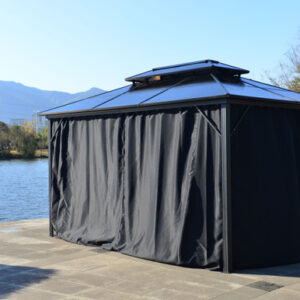
By now, you’re probably excited about all the possibilities of adding a gazebo to your yard. But what’s the installation like?
Gazebo installation can be complex or very simple, depending on the type of gazebo you choose. For a wooden gazebo, you’ll need to do more site prep, such as leveling the ground and clearing vegetation. For ready-to-assemble metal gazebos, you’ll simply need to choose a level area on your lawn or space on your deck.
When choosing your location, take a few points into consideration:
- Distance from the home – Closer to the house is easier if you intend to use your gazebo for outdoor dining. Remember, you’ll be carrying food and drinks out to whatever location you choose.
- Sun exposure – If you live in a cooler climate, you may want to choose a location that gets morning or afternoon sun. In hotter zones, choose a shady area of the yard to keep the gazebo comfortable even in hot weather.
- Beautifying the garden – If you want your gazebo to serve as a garden focal point, consider locating it further from the house, with a gravel or flagstone path leading to it. A semi-private location for your gazebo will encourage visitors to stroll through the yard and enjoy your landscaping.
Expand Your Outdoor Living Space with ALEKO
Whether you want to host outdoor parties, enjoy a romantic dinner, or simply unwind in a peaceful setting, a gazebo is a versatile and beautiful addition to any outdoor space. Adding a gazebo to your yard can be a big project requiring skilled labor and costly materials, but it doesn’t have to be.
ALEKO offers high-quality gazebos in timeless styles that allow you to get more use out of your outdoor space and add value to your home, without taking on a difficult and expensive landscaping project.
Browse our selection of elegant and durable steel luxury gazebos to find the perfect gazebo for your lifestyle. Contact our team today for help deciding on the best options to create your own outdoor oasis.
Sources:
Angi. Cost to build a gazebo: A complete guide. https://www.angi.com/articles/gazebo-cost.htm
Garden Patch. Who invented the gazebo and when? A history of ancient gazebos. https://www.gardenpatch.co.uk/who-invented-the-gazebo/
SF Gate Home Guides. How to care for a gazebo. https://homeguides.sfgate.com/care-gazebo-71829.html
This Old House. How to build a great gazebo. https://www.thisoldhouse.com/yards/21015401/building-a-great-gazebo

